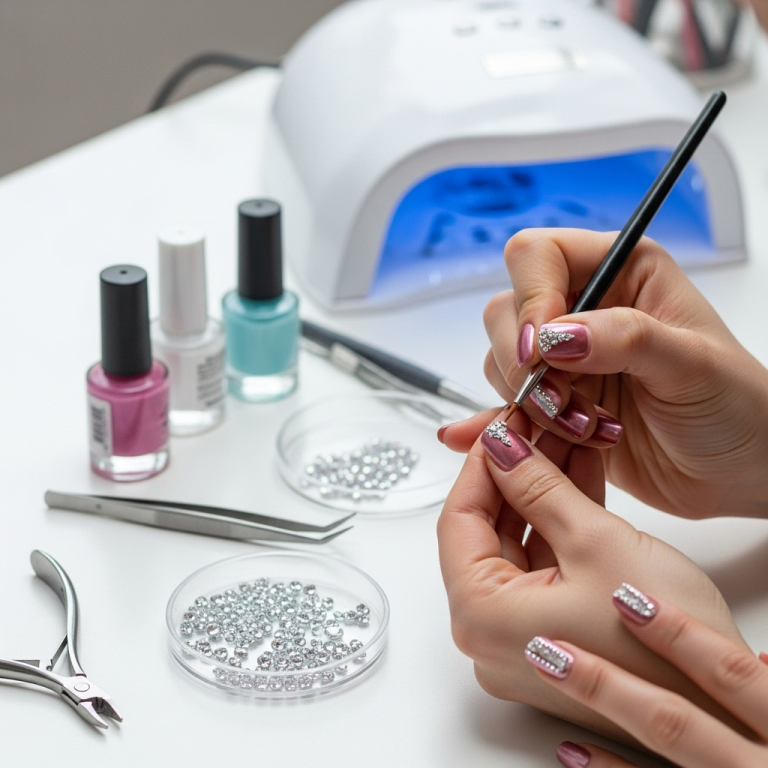Gothic lace nail designs offer an elegant, edgy way to express your style. Easily achievable for beginners, these designs use dark colors and delicate lace patterns to create stunning, sophisticated manicures. Learn simple techniques to get this chic look at home!
Dreaming of nails that are both mysterious and absolutely gorgeous? Gothic lace nail designs are a fantastic way to add a touch of dark romance and intricate beauty to your look. While they might seem complex, creating these stunning designs is totally doable, even if you’re new to nail art! Forget stressing about complicated patterns; we’re going to break down how to get that elegant, dark, and dreamy lace effect right at your fingertips.
This guide is packed with simple tips and easy-to-follow steps. Whether you love a deep black, a moody burgundy, or a sophisticated grey, gothic lace nails can be customized to fit your unique vibe. Get ready to transform your nails into tiny works of art that are sure to turn heads!
What Exactly Are Gothic Lace Nail Designs?
Gothic lace nail designs are all about capturing the intricate, delicate, and often dark beauty of lace patterns, applied to your nails. Think of flowing lines, floral motifs, and filigree details, all rendered in classic gothic color palettes like black, deep reds, purples, greys, and sometimes even stark whites or silvers for contrast. It’s a style that blends romance with a hint of rebellion, perfect for expressing individuality.
The “gothic” aspect often refers to the dark, dramatic colors used, while the “lace” signifies the intricate, often airy patterns that mimic real lace fabric. These designs can range from a full lace overlay on every nail to subtle lace accents on accent nails. They’re versatile enough to be glamorous, spooky, or elegantly understated.
Why You’ll Love Gothic Lace Nails
There are so many reasons why this trend has captured the hearts of nail art lovers:
- Timeless Elegance: Lace is a classic motif that never goes out of style. When paired with dark, rich colors, it creates a look that’s both sophisticated and a little bit edgy.
- Versatile Style: Whether you’re dressing up for a special occasion or just want to add a unique touch to your everyday look, gothic lace nails fit the bill. They work with almost any outfit and mood.
- Self-Expression: These designs allow you to play with color, pattern, and finish. You can choose bold, all-over lace, or keep it subtle with small details.
- Achievable for Beginners: With the right tools and techniques (which we’ll cover!), even novice nail artists can achieve beautiful gothic lace manicures.
- The “Wow” Factor: Intricate patterns naturally draw the eye, making your nails a stunning focal point. People will notice and compliment your creativity!
Essential Tools for Gothic Lace Nail Art
You don’t need a professional salon setup to create amazing gothic lace nails. Here’s what you’ll want to have on hand:
| Nail Polish Colors | Lace Application Tools | Finishing & Cleanup | Optional Extras |
|---|---|---|---|
| Base Coat: For nail health and polish adhesion. | Fine-Tip Nail Art Brush: Your primary tool for painting lace designs. Look for brushes with very thin, precise bristles. | Top Coat: To seal your design, add shine, and protect your manicure. A matte top coat can also create a beautiful textural contrast. | Rhinestones or Glitter: For added sparkle and dimension. Black or silver studs are perfect for a gothic look. |
| Main Color Polish: Black, deep red, navy, dark purple, grey, or forest green are popular choices for the nail base. | Dotting Tool: Useful for creating small dots that can form part of lace patterns or be used to place embellishments. | Cuticle Pusher & Cleaner: To gently push back cuticles before painting and clean up any stray polish. | Stencils or Decals: Pre-made lace stencils or water decals can simplify the process. |
| Accent Color Polish: White, silver, or a lighter shade of your base color for the lace pattern itself, or black if you’re using a lighter base. | Nail Art Pen: These can be easier for beginners than brushes, offering good control for drawing fine lines. | Lint-Free Wipes: Essential for cleaning brushes and wiping away mistakes without leaving fibers. | Nail Glue (if using 3D elements): For attaching larger embellishments like charms or custom 3D lace pieces. |
| Sponge (for gradients): If you plan a gradient base, a makeup sponge can help create a smooth transition. | Rubbing Alcohol or Nail Polish Remover: For cleaning tools and correcting errors. | ||
| Tweezers: Useful for picking up small decals or embellishments. | Cuticle Oil: To nourish your cuticles after the manicure is complete. |
Getting Started: The All-Important Prep Work
Before any masterpiece can be created, you need a perfect canvas. Proper nail preparation is key to a long-lasting and professional-looking gothic lace manicure.
Step 1: Cleanse and Shape
Start with clean, dry nails. Remove any old polish thoroughly. Gently push back your cuticles; avoid cutting them if possible, as this can lead to infection. For best results, trim and file your nails into your desired shape. Smooth out any ridges with a buffer.
Step 2: Apply Base Coat
A good base coat is crucial. It protects your natural nails from staining (especially important with dark polishes!) and helps your colored polish adhere better, preventing chips. Apply one thin layer and let it dry completely.
Step 3: Your Base Color
Apply two thin coats of your chosen base polish. This will be the main color of your nail, providing the background for your lace design. Let each coat dry fully. Patience here is rewarded with a smoother, more professional finish. Dark, rich colors like black, deep plum, or navy blue are perfect for a classic gothic look.
DIY Gothic Lace Nail Designs: Techniques for Beginners
Now for the fun part! Here are a few beginner-friendly ways to achieve stunning gothic lace effects:
Technique 1: Hand-Painting Simple Lace
This is where your fine-tip brush or nail art pen comes into play. Don’t feel intimidated – even simple patterns can look incredibly elegant.
Step 1: Practice Lines
Before diving into a full design, practice drawing thin, consistent lines on a piece of paper or a nail file. Get a feel for the pressure needed and how the polish flows.
Step 2: Start with Dots
For a simple lace effect, create a series of small dots with your accent color (e.g., white on black, or silver on deep red). Place them strategically, perhaps near the cuticle or along the free edge.
Step 3: Connect the Dots
Using your fine-tip brush or pen, gently connect the dots with thin, fluid lines. You can create small loops, curves, or zigzags. Imagine creating a delicate web or floral vine.
Step 4: Add Details
Once you have a basic pattern, add smaller dots or tiny flicks to create more intricate detailing. Think of it like sketching – build up the pattern gradually.
Step 5: Accent Nails
You don’t need to do lace on every nail. Consider doing full lace on one or two accent nails and a simple solid color on the others for a balanced look.
Pro-Tip: To avoid a muddy look, clean your brush thoroughly between dipping into polish and between adding different elements of the design. Keeping your lines thin is key for an authentic lace appearance.
Technique 2: Using Nail Stencils
Stencils are wonderful for beginners, providing clean, crisp lines with minimal effort.
Step 1: Place the Stencil
Apply your base colored polish and let it dry completely. Carefully position the lace stencil onto your nail. Ensure it adheres smoothly to avoid polish seeping underneath.
Step 2: Paint Over
Using your contrast color (e.g., black polish, white polish, or even a stamping polish), gently dab or brush it over the open parts of the stencil. Don’t use too much polish, or it will bleed.
Step 3: Remove Stencil
While the polish on the stencil is still wet, very carefully peel off the stencil using tweezers. Doing this while the polish is wet prevents the stencil from lifting the dried polish design with it.
Step 4: Clean Up
Use a small brush dipped in nail polish remover to clean up any smudges around your nail and cuticle.
Technique 3: Lace Water Decals
Water decals are possibly the easiest way to achieve a complex lace look almost instantly!
Step 1: Prepare Nails
Apply your base coat and main color polish. Ensure it’s completely dry. Apply a regular top coat and let it get slightly tacky, or use a dedicated decal adhesive. This will help your decal stick.
Step 2: Cut and Soak
Carefully cut out the lace decal you want to use. Place it image-side down in a small dish of lukewarm water for about 20-30 seconds, until the design starts to separate from the backing paper.
Step 3: Apply the Decal
Gently slide the decal from the backing paper onto your nail. Use a brush or your fingertip to smooth out any wrinkles and position it perfectly. You have a little time to adjust its placement.
Step 4: Remove Backing
Carefully peel away the remaining backing paper. You should be left with the lace design adhered to your nail.
Step 5: Seal It In
Once the decal is in place and you’re happy with it, apply a generous layer of top coat. This is important to fully seal the decal and make it look like it’s painted on.
Technique 4: Using Lace Fabric or Real Lace (Advanced Beginner/Intermediate)**
This method offers a truly textured, authentic lace look. It requires a bit more care, but the results are incredibly unique. For tips on safe nail practices, consult resources like the NIOSH guide on nail salon worker safety, which highlights important hygiene and product handling procedures relevant to any nail art endeavor.
Step 1: Prepare Base
Paint your nails with your chosen dark base color and let it dry completely. You want a fully cured surface.
Step 2: Cut Real Lace
Cut a small piece of actual lace fabric (or a special nail art lace material) to fit your nail. Make sure it’s thin and delicate.
Step 3: Apply Adhesive
Apply a thin layer of clear nail glue or a strong top coat to the nail where you want the lace to go.
Step 4: Place Lace
Carefully lay the cut lace piece onto the sticky surface of the nail. Press gently to ensure it adheres well.
Step 5: Seal with Top Coat
Apply several thin layers of top coat over the lace. This is crucial to embed the lace into the polish and create a smooth surface. Allow ample drying time between coats.
Design Ideas to Inspire You
Ready to get creative? Here are some popular gothic lace nail design variations:
- Classic Black & White: Black base with intricate white lace patterns is the ultimate gothic staple.
- Deep Red Romance: Burgundy or deep crimson base with black or gold lace for a dramatic, vampy look.
- Moody Blues & Purples: Navy, deep teal, or royal purple base with silver or grey lace for an ethereal, mysterious vibe.
- Gothic French Tips: Instead of a white tip, paint a delicate lace pattern along the tip of a nude or sheer base nail.
- Half-Moon Lace: Apply a crescent-shaped lace detail at the cuticle area on a solid base color.
- Gradient Lace: Create a smooth gradient of dark colors (e.g., black to deep purple) and then add delicate lace details over the top.
- Lace with Embellishments: Add small black or silver rhinestones, studs, or pearls at the intersection points of your lace design for extra drama.
- Matte vs. Glossy: Try a matte top coat over a glossy lace design, or vice versa, for a sophisticated textural contrast.
Tips for Long-Lasting Gothic Lace Nails
Want your beautiful designs to last? Follow these tips:
- Clean & Dry: Always start with clean, dry nails free of oils and lotions.
- Quality Top Coat: Invest in a good, durable top coat. Apply it generously to seal everything in.
- Cap the Edges: When applying your base color and top coat, sweep a little polish along the free edge (the tip) of your nail. This helps prevent chipping.
- The “Bumping” Method (for decals): After applying a decal and sealing it with top coat, you can gently “bump” the surface with a slightly damp cotton swab to help it meld into the top coat, making it less prone to lifting. Be very gentle!
- Avoid Harsh Chemicals: Wear gloves when doing chores involving water or cleaning products, as these can break down polish and lift designs.
- Reapply Top Coat: You can extend the life of your manicure by reapplying a thin layer of top coat every 2-3 days.
Gothic Lace Design Comparison
Here’s a quick look at some popular gothic lace design approaches. We’ll compare them based on ease of application, visual complexity, and overall look.
| Design Method | Ease for Beginners | Visual Complexity | Typical Time | Level of Effort | Best For |
|---|---|---|---|---|---|
| Hand-Painted Lines | Medium (requires practice) | High (can be very intricate) | 20-45 mins per nail | Medium to High | Detailed, personalized designs |
| N
|



